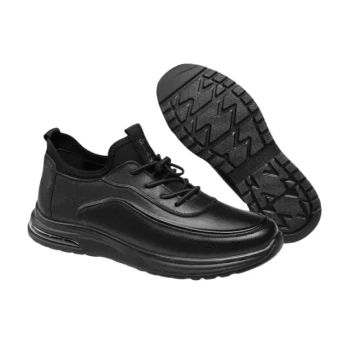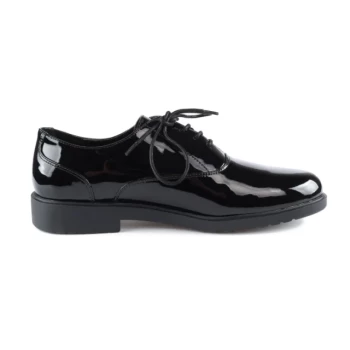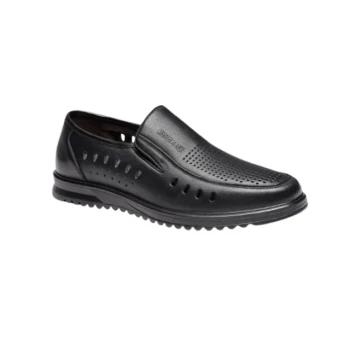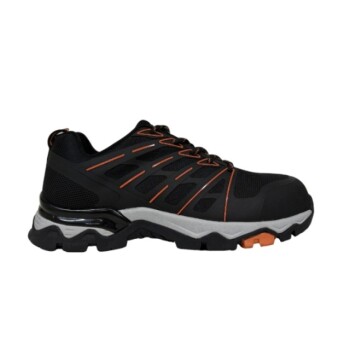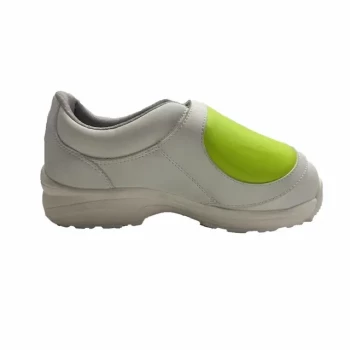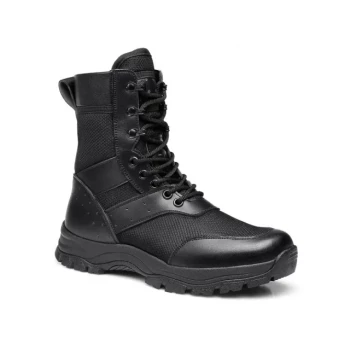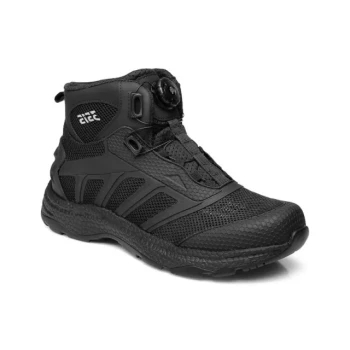In short, formal shoes are almost exclusively made from smooth leather, while casual shoes utilize a much broader palette, including fabrics like canvas, textured leathers like suede, and various synthetic materials. The specific material choice is the most significant indicator of a shoe's intended purpose and level of formality.
The core principle is simple: smoothness signals formality, while texture signals a more casual intent. A shoe's material—from its upper to its sole—is the primary language it uses to communicate its place in a wardrobe.
The Defining Materials of Formal Footwear
Formal shoes are built around a narrow set of materials chosen for their sleek appearance, durability, and ability to convey tradition and professionalism.
The Dominance of Smooth Leather
The undisputed standard for formal shoe uppers is a high-quality, smooth leather, such as calfskin. Its fine grain allows for a high-gloss polish, creating a clean and elegant profile required for business and ceremonial occasions.
Other premium leathers like Cordovan may also be used for high-end formal footwear, prized for their exceptional durability and rich patina.
Faux and Vegan Leather Alternatives
Modern shoemaking also includes high-quality faux or vegan leathers. These synthetic materials are designed to closely mimic the appearance and shine of real leather, offering a formal look for those who prefer non-animal products.
The Foundation: Sole and Construction
A traditional formal shoe features a leather sole, which is often thinner and more rigid than its casual counterparts. It typically has a distinct, separately attached heel block.
In high-quality construction methods like a Goodyear welt, the space between the insole and outsole is filled with materials like cork, which gradually molds to the wearer's foot for a custom fit.
The Versatile Palette of Casual Shoes
Casual footwear prioritizes comfort, variety, and expression, which is reflected in its wide range of materials.
The Role of Leather in Casual Wear
Leather is not exclusive to formalwear, but its form changes for casual use. Suede and nubuck, which are leathers with a napped, velvet-like texture, are staples of business casual and smart casual shoes.
Even smooth leather can be used in casual shoes like "dress sneakers," but it's typically paired with a rubber sole to signal a more relaxed purpose.
The World of Fabrics and Textiles
Fabrics are a hallmark of casual shoes. Canvas is a durable, breathable cotton fabric common in sneakers and summer shoes.
Other materials like linen and various synthetic textiles offer lightweight comfort and a vast array of colors and patterns not found in formal footwear.
The Casual Sole: Rubber and Synthetics
The most common material for casual shoe soles is rubber or other synthetic compounds. These soles are valued for their flexibility, traction, and comfort.
They can range from thin, flat profiles on sneakers to thick, chunky soles on boots and modern fashion footwear, a stark contrast to the sleek leather soles of dress shoes.
Understanding the Key Trade-offs
The choice between formal and casual materials involves a balance of appearance, practicality, and context.
Formality vs. Function
Smooth leather is formal but can be less breathable than fabric. Canvas and linen are excellent for warm climates but offer little protection from the elements and are inappropriate for formal settings.
Durability and Maintenance
High-quality leather, when properly cared for, is exceptionally durable. Suede is also durable but requires specialized cleaning to protect its textured surface from water and stains. Canvas is easy to clean but may show wear more quickly.
Color as a Signal
Material choice often dictates the color palette. Formal shoes stick to dark, conservative colors like black, dark brown, and oxblood. Casual shoes embrace the full spectrum, from vibrant reds and blues to neutral tans and classic black or navy.
Making the Right Choice for Your Goal
Your choice of shoe material should be a direct reflection of the occasion and the impression you wish to make.
- If your primary focus is business formal or black-tie events: A smooth leather shoe in a dark color with a leather sole is the only appropriate choice.
- If your primary focus is business casual or smart casual: Suede or leather uppers paired with a rubber sole offer the perfect blend of refinement and comfort.
- If your primary focus is everyday comfort and relaxed settings: Canvas, textiles, and other fabric-based shoes provide maximum comfort, breathability, and style versatility.
Ultimately, understanding these material differences empowers you to navigate any dress code with confidence.
Summary Table:
| Shoe Type | Common Upper Materials | Common Sole Materials | Key Characteristics |
|---|---|---|---|
| Formal Shoes | Smooth Leather (Calfskin, Cordovan), Vegan Leather | Leather Sole | Sleek, polished appearance; ideal for business/formal events |
| Casual Shoes | Suede, Nubuck, Canvas, Textiles, Synthetics | Rubber, Synthetic Soles | Comfortable, versatile, breathable; perfect for everyday wear |
Need a Reliable Manufacturer for Your Shoe Line?
As a large-scale manufacturer, 3515 produces a comprehensive range of footwear for distributors, brand owners, and bulk clients. Whether you need classic formal leather shoes or trendy casual sneakers, our production capabilities encompass all types of shoes and boots.
We offer:
- Expert Material Sourcing: High-quality leathers, textiles, and soles.
- Scalable Production: From small batches to large-volume orders.
- Customization: Tailor styles, materials, and branding to your market.
Let's create the perfect shoes for your customers. Contact us today to discuss your production needs!
Related Products
- Custom Manufactured Air Cushion Leather Business Shoes for Wholesale
- Wholesale Patent Oxford Dress Shoes | Custom & Bulk Manufacturing
- Wholesale Comfortable Business Casual Shoes Custom Manufacturing
- Wholesale Leather Derby Shoes Manufacturer | Customizable Business & Dress Footwear
- Wholesale Comfort Leather Business Shoes with Dial Lacing System
People Also Ask
- Can sneakers be part of a business casual wardrobe? Yes, with the right style and fit
- What are the benefits of calf leather for dress shoes? Unmatched Elegance & Comfort
- How does leather compare to other shoe materials in terms of durability and comfort? A Material Guide for Footwear
- What are the characteristics of business casual sneakers? Master the Polished & Professional Look
- Why are sneakers now accepted in office environments? The Shift to Modern Professionalism
